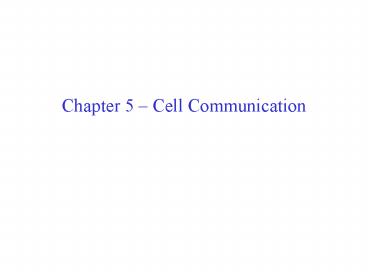Chapter 5 - PowerPoint PPT Presentation
1 / 61
Title:
Chapter 5
Description:
... Figure 13.4 The human life cycle Figure 13.5 Three sexual life cycles differing in the timing of meiosis ... protein Chapter 12 Cell Life Cycle ... – PowerPoint PPT presentation
Number of Views:178
Avg rating:3.0/5.0
Title: Chapter 5
1
Chapter 5 Cell Communication
2
Figure 11.0 Yeast
3
Figure 11.1 Communication between mating yeast
cells
4
Figure 11.3 Local and long-distance cell
communication in animals
5
Figure 11.4 Communication by direct contact
between cells
6
Figure 11.5 Overview of cell signaling (Layer 3)
7
Figure 11.6 The structure of a G-protein-linked
receptor
8
Figure 11.7 The functioning of a
G-protein-linked receptor
9
Figure 11.8 The structure and function of a
tyrosine-kinase receptor
10
Figure 11.9 A ligand-gated ion-channel receptor
11
Figure 11.10 Steroid hormone interacting with an
intracellular receptor
12
Figure 11.11 A phosphorylation cascade
13
Figure 11.13 cAMP as a second messenger
14
Figure 11.12 Cyclic AMP
15
Figure 11-12x cAMP
16
Figure 11.14 The maintenance of calcium ion
concentrations in an animal cell
17
Figure 11.15 Calcium and inositol triphosphate
in signaling pathways (Layer 3)
18
Figure 11.16 Cytoplasmic response to a signal
the stimulation of glycogen breakdown by
epinephrine
19
Figure 11.17 Nuclear response to a signal the
activation of a specific gene by a growth factor
20
Figure 11.18 The specificity of cell signaling
21
Figure 11.19 A scaffolding protein
22
Chapter 12 Cell Life Cycle
23
Figure 12.0 Mitosis
24
(No Transcript)
25
(No Transcript)
26
(No Transcript)
27
(No Transcript)
28
(No Transcript)
29
Figure 12.1c The functions of cell division
Tissue renewal
30
Figure 12.2 Eukaryotic chomosomes
31
Figure 12.3 Chromosome duplication and
distribution during mitosis
32
Figure 12.5 The stages of mitotic cell division
in an animal cell G2 phase prophase
prometaphase
33
Figure 12.5 The stages of mitotic cell division
in an animal cell metaphase anaphase telophase
and cytokinesis.
34
Figure 12.5x Mitosis
35
Figure 12.6 The mitotic spindle at metaphase
36
Figure 12.7 Testing a hypothesis for chromosome
migration during anaphase
37
Figure 12.8 Cytokinesis in animal and plant cells
38
Figure 12.9 Mitosis in a plant cell
39
Figure 12-09x Mitosis in an onion root
40
Figure 12.10 Bacterial cell division (binary
fission) (Layer 3)
41
Figure 12.15 The effect of a growth factor on
cell division
42
Figure 12.16 Density-dependent inhibition of
cell division
43
Figure 12.17 The growth and metastasis of a
malignant breast tumor
44
Figure 12-17x1 Breast cancer cell
45
Figure 12-17x2 Mammogram normal (left) and
cancerous (right)
46
Figure 13.1 The asexual reproduction of a hydra
47
Figure 13.x1 SEM of sea urchin sperm fertilizing
egg
48
Figure 13.3 Preparation of a human karyotype
(Layer 4)
49
Figure 13.x2 Human female chromosomes shown by
bright field G-banding
50
Figure 13.x3 Human female karyotype shown by
bright field G-banding of chromosomes
51
Figure 13.x4 Human male chromosomes shown by
bright field G-banding
52
Figure 13.x5 Human male karyotype shown by
bright field G-banding of chromosomes
53
Figure 13.4 The human life cycle
54
Figure 13.5 Three sexual life cycles differing
in the timing of meiosis and fertilization
(syngamy)
55
Figure 13.6 Overview of meiosis how meiosis
reduces chromosome number
56
Figure 13.7 The stages of meiotic cell division
Meiosis I
57
Figure 13.7 The stages of meiotic cell division
Meiosis II
58
Figure 13.8 A comparison of mitosis and meiosis
59
Figure 13.8 A comparison of mitosis and meiosis
summary
60
Figure 13.9 The results of alternative
arrangements of two homologous chromosome pairs
on the metaphase plate in meiosis I
61
Figure 13.10 The results of crossing over during
meiosis































